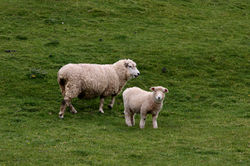
Reproductive Cloning
WHAT IS CLONING?
"Cloning is a complex process that lets one exactly copy the genetic, or inherited, traits of an animal (the donor).Most people think of livestock breeding taking place through traditional mating, in which males and females physically get together to reproduce. In fact, this is not often the case.Traditional mating is not that efficient, if the goal is to produce as many offspring as possible. For example, a male has enough sperm to produce many more offspring than would be possible by traditional mating. Traditional mating also has certain risks: one or both of the animals may be injured in the process of mating. The female may be hurt by the male because he is often much larger, or an unwilling female may injure the male. There is also a risk of infection or transmission of venereal disease during traditional mating.Because of these factors, many farmers use assisted reproductive technologies (ARTs) for breeding. These include artificial insemination, embryo transfer, and in vitro fertilization (a process by which egg and sperm are united outside the body).In all of the other assisted reproductive technologies, the male and female parents each contribute half of their genes to their offspring. Farmers have worked for years to choose animals with the best traits and breed them together. This increases the chance these good traits will be passed on and become more common in livestock herds. Even though farmers have been able to improve their herds over time, they still can’t absolutely predict the characteristics of the offspring, not even their gender. Cloning gives the farmer complete control over the offspring’s inherited traits. Thus, a farmer who clones an especially desirable but aging or injured animal knows in advance that the clone will have the genetic potential to be an especially good, younger animal. He can then use that animal to further reproduce by traditional mating or other ARTs. Some people incorrectly believe that clones spring forth fully formed, or are grown in test tubes. This is just not the case.Cloning is a more advanced form of these assisted reproductive technologies.Clones are born just like other animals. They are similar to identical twins, only born at different times. Just as twins share the same DNA, clones have the same genes as the donor animal. A clone is not a mutant, nor is it a weaker version of the original animal.Most cloning today uses a process called somatic cell nuclear transfer (SCNT). Just as with in vitro fertilization, scientists take an immature egg, or oocytes, from a female animal (often from ovaries obtained at the slaughterhouse). But instead of combining it with sperm, they remove the nucleus (which contains the oocytes’s genes). This leaves behind the other components necessary for the initial stages of embryo development. Scientists then add the nucleus or cell from the donor animal that has the desirable traits the farmer wishes to copy. After a few other steps, the donor nucleus fuses with the ooplast (the oocytes whose nucleus has been removed), and if all goes well, starts dividing, and an embryo begins to form. The embryo is then implanted in the uterus of a surrogate dam (again the same as with in vitro fertilization), which carries it to term. ("Dam" is a term that livestock breeders use to refer to the female parent of an animal). The clone is delivered just like any other baby animal."
CLONING OF PLANTS

"The process of producing plants that are genetically identical to their mother plant is called cloning. Also known as vegetative propagation, it is the most common technique of asexual reproduction that produces an exact copy of original plant. The resultant plant is called clone having same genetic blueprint as that of mother plant. Almost every vegetable like potato, tomato, cabbage, chili etc. can be cloned through this process."
Some benefits include:
-
Reliable yields
-
Reproduce at faster rates
-
More economical to produce seeds through cloning process
-
More food for the overall population but decrease in overall cost
-
Diseases can be limited
-
Plant species that are almost extinct can be saved
-
Develop fruits and vegetables of superior nutritional value
-
If seeds are scarce, they can be easily grown through cloning

CLONING OF ANIMALS
"In reproductive cloning, researchers remove a mature somatic cell, such as a skin cell, from an animal that they wish to copy. They then transfer the DNA of the donor animal's somatic cell into an egg cell, or oocyte, that has had its own DNA-containing nucleus removed.
Researchers can add the DNA from the somatic cell to the empty egg in two different ways. In the first method, they remove the DNA-containing nucleus of the somatic cell with a needle and inject it into the empty egg. In the second approach, they use an electrical current to fuse the entire somatic cell with the empty egg.
In both processes, the egg is allowed to develop into an early-stage embryo in the test-tube and then is implanted into the womb of an adult female animal.
Ultimately, the adult female gives birth to an animal that has the same genetic make up as the animal that donated the somatic cell. This young animal is referred to as a clone. Reproductive cloning may require the use of a surrogate mother to allow development of the cloned embryo, as was the case for the most famous cloned organism, Dolly the sheep."
WHAT ANIMAL HAS BEEN CLONED?
 Dolly the Sheep |  Pigs |  Cat and Dog |
|---|---|---|
 Deer |  Horse |  Gray Wolves |
 Mice |  Wild Goat |








